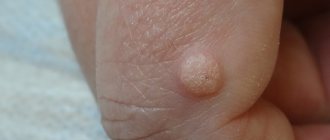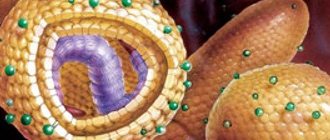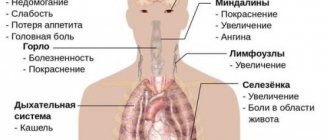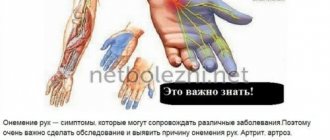Viral warts are a very common ailment that may not bother a person in any way, but can become a serious cosmetic defect and cause significant discomfort depending on the size and location. Very often they rub against clothes, shoes, jewelry and at the same time begin to bleed and become inflamed. Viral warts look like small growths with signs of hyperkeratization, brown or flesh-colored. Most often they are single, but they can also form groups. They are usually located on the arms, on the soles of the feet, in the armpits, and in the anogenital area. Warts are caused by human papillomavirus, and some strains of the virus are oncogenic; such tumors must be removed.
Viral warts have several types of manifestation:
- ordinary - localized on the hands, they are dense, knot-like growths with a rough surface;
- plantar - as the name suggests, they form on the soles and experience additional effects in the form of rubbing and increased sweating. They are characterized by internal growth and cause pain when walking.
- flat - usually small in size, with a smooth surface, localized on the neck, face, hands;
- anogenital (pointed) - localization site - mucous membrane and skin of the genital organs, can remain unnoticed for quite a long time, but are transmitted sexually.
The formation of viral warts is provoked by decreased immunity, neglect of personal hygiene, stress, hormonal imbalances, and skin trauma.
The Internet offers a huge variety of ways to get rid of warts on your own. But doctors, who have seen in their practice many cases of serious complications after such “disastrous treatment”, strongly recommend not to take risks and decide on the feasibility and method of removing the tumor only together with a dermatologist. Modern dermatology offers a wide range of treatments for viral warts, all of them are quite effective, harmless, characterized by the absence of complications and postoperative infection, and are performed in one visit to a medical facility and are affordable.
Symptoms and types of warts on the foot
A plantar wart appears as a callus-like thickening with a stratum corneum layer of skin. It interferes with walking and causes pain. The passive state is characterized by slow reproduction, not reaching the stratum corneum of the epithelium, so this condition does not manifest itself externally.
The active state is characterized by the fact that the virus develops rapidly and, rising to the upper layers of the epidermis, manifests itself in numerous symptoms. The plantar wart is also called the spinous wart, chicken wart. The virus enters during its contact with the skin through cuts and abrasions in the outer layer of the skin:
- First, a small yellowish-gray papule with an uneven surface appears.
- Gradually, the small element becomes dense and acquires a dirty color.
From the inside, a plantar wart looks like fused papillae of different sizes with a pinkish tint. Additional capillary vessels form there, causing bleeding if you catch a wart.
How to get rid of small warts
It is better to get rid of warts earlier.
Don't wait until they reach large sizes.
Moreover, there is no need to wait until the wart becomes the cause of a malignant tumor.
It is better to go to the doctor and remove all formations once and for all.
This will require a total of 1-2 hours of your time.
Removal will be safe and completely painless.
But all warts are guaranteed to disappear.
And with proper medical treatment, the risk of their reappearance will be minimized.
There are several types of treatment that a person with small warts on the body can receive.
He is receiving systemic therapy.
It is aimed at destroying viruses in the body.
A person is prescribed immunomodulators and antiviral drugs.
Treatment is also used to remove the warts themselves.
HPV strains
There are strains of the virus that have a high oncogenic potential. They are designated by numbers 16, 18, 39, 45, 56, 68, 73 and 82. There are also options with medium (26, 31, 33, 35, 51, 52, 53, 58 and 66) and low (6.11, 40, 42, 43, 44, 54, 61, 70, 72, 81) oncogenicity. Cervical cancer is most often associated with infection with strains 16 and 18, therefore, when such a virus is detected, maximum monitoring of the patient’s condition is required.
Important clarification! Highly oncogenic viruses detected in the body do not mean that a person will necessarily have cancer. This increases the risk of developing cancer, but is not a 100% determining cause. Moreover, oncology is usually preceded by so-called precancerous conditions. With regular monitoring, doctors have a very high chance of “catching” the disease at an early stage and preventing it from developing into cancer. And cancer itself at the first stage is treated quite successfully. If you have been diagnosed with a virus, do not panic - with proper control, this is not a death sentence for your health and life.
Removal of plantar warts
It is worth treating a plantar wart if:
- There are painful sensations.
- The wart is bleeding.
- There were spots on it.
- The wart quickly increases in size.
There are many treatment methods. One of them is cryodestruction. The meaning of the method is that the wart is exposed to liquid nitrogen at a temperature of minus 196 degrees. The virus-affected area is frozen and the wart is removed.
The usual and aggressive method of exposure is used. With the aggressive method, nitrogen is applied for a few seconds longer, but this method is more painful. It is important to note that if a wart appears and exists for more than six months, then the effectiveness of cryodestruction is greatly reduced, and the meaning of such an operation, accordingly, also disappears.
After removing a plantar wart using liquid nitrogen, you should follow some recommendations:
- the blister remaining at the site of the wart cannot be opened;
- to avoid mechanical damage, use a sterile bandage rather than a plaster;
- Treat the affected area with salicylic alcohol 2% twice a day;
- try to prevent water from entering the affected area.
Another method is laser coagulation. This is one of the most common methods for removing warts. Most laser systems are equipped with a special cooling system. Thus, the procedure takes place with minimal discomfort and does not allow inflammation, since the laser has antiseptic properties. Moreover, this is a non-contact method.
There are several ways:
- Carbon dioxide (CO2) laser. Treatment in this case occurs using infrared light. The method is 70% effective, but the downside is that healthy tissue can also be damaged.
- Erbium laser. This treatment method uses a shorter wavelength, which reduces the likelihood of scarring after surgery. Efficiency is typically 75%.
- Pulsed dye laser. With this method of exposure, the primary destruction of dilated capillaries in the wart and stimulation of the immune system, which contributes to effective healing. The effectiveness of treatment is about 95%.
After laser treatment, a crust forms on the affected area, which disappears on its own within seven to ten days. The recommendations for this method of treatment are the same as after exposure to nitrogen - avoid mechanical damage and ingress of water.
The next way to remove warts is electrocoagulation. In this case, a high frequency current is applied to the wart. Treatment is carried out under local anesthesia. Exposure of a wart to high temperatures leads to the evaporation of cells affected by the papilloma virus. Another advantage of this method is that cauterization of blood vessels prevents bleeding. After surgery, a crust forms on the affected area of the skin, which disappears within 7 to 10 days.
A plantar wart can be treated with direct surgery. In this case, excision occurs under local anesthesia, then sutures are applied. After the operation, the doctor will prescribe certain recommendations. Thus, it is recommended to prevent water and soap from entering the affected area, not to tear off the resulting crust, and to treat the affected area with an antiseptic in the first 7-10 days.
For each type of operation there are certain contraindications. Thus, it will be impossible to perform the operation if the following occurs:
- pregnancy;
- diabetes;
- malignant tumors in the body;
- infection and inflammation around the wart;
- exacerbation of herpes;
- elevated temperature.
If your blood pressure is high, the procedure should also be postponed.
Preparations for the treatment of small warts
You can remove warts using the following methods:
- cytotoxic;
- chemical;
- physical.
The first two involve treating the skin with special preparations.
With the cytotoxic method, the skin is treated repeatedly.
With chemical treatment, a single treatment is carried out, as a result of which the wart tissue dies and is rejected.
Podophyllotoxin is mainly used for cytotoxic removal.
This is an extract of the roots of Podophyllum thyroid.
Apply it for 3 days in a row.
Then they take a break for 4 days.
If the warts do not disappear, the course is repeated.
There can be no more than five such courses in total.
If there is no effect, other, more effective treatment methods are used.
Possible side effects of using podophyllotoxin:
- redness;
- burning;
- pain;
- ulcers at the site of application;
- edema.
When removing warts on the penis, balanoposthitis may develop.
If an excessively large dose is used or a large area is treated, the components of the drug may be absorbed into the blood.
Then systemic side effects occur:
- nausea;
- dizziness;
- diarrhea;
- increase in body temperature;
- a decrease in the number of blood cells due to suppression of red bone marrow function;
- the appearance of ulcers in the mouth.
Chemical removal methods are also used.
For this purpose, concentrated solutions of alkalis or acids are used.
That is, substances that cause chemical burns of the skin followed by necrosis and tissue rejection.
Such drugs are often used by patients on their own.
Although this possibility is not specified in the instructions.
It states that removal can only be performed by a doctor experienced in performing this type of procedure.
Chemical removal is dangerous if done incorrectly.
It is necessary to treat the skin located nearby with Vaseline or oil.
Otherwise it will also be damaged.
When using a large amount of solution or increasing the exposure time, scar formation may occur.
They are formed as a result of a deep burn of the skin.
When trying to remove small warts on the penis, phimosis may form.
The disadvantages of home removal of formations are as follows:
- Is it dangerous;
- hurt;
- is fraught with side effects;
- not always effective;
- After removal, there remains a high risk of relapse.
Therefore, it is better to remove these formations using physical methods.
Complications of small warts
Even the smallest warts on the chin or other parts of the body can cause complications.
Including life-threatening ones.
Some types of papillomavirus can cause cancer.
These are squamous cell skin cancer, cervical carcinoma, cancer of the penis, esophagus, larynx, and rectum.
The appearance of a tumor is usually preceded by precancerous processes.
They can be identified during the examination.
These processes have been going on for years.
Therefore, if a person monitors his health and visits a doctor, then he is protected from these complications.
Because if foci of pathologically altered epithelium are detected, they can be removed.
As a result, transformation into cancer does not occur.
If a person ignores his illness, is not examined and is not treated, then he puts himself at risk.
People who are not bothered by small warts or if they are in places inaccessible for self-examination do not go to the doctor.
Other possible complications:
- wart rupture and bleeding;
- inflammatory processes due to bacterial superinfection;
- scar formation as a result of mechanical damage to warts.
Sometimes borderline tumors develop.
With anogenital localization, human papillomavirus infection can occur in the form of giant Buschke-Levenshtein condyloma.
It is characterized by infiltrative, destructive growth.
The tumor grows, destroying surrounding tissue.
It reaches enormous sizes and often recurs after removal.
Therefore, the overall mortality rate for giant condyloma reaches 60%, despite the possibility of surgical treatment.
Questions and answers
How to get rid of the human papillomavirus forever?
It is impossible to get rid of it 100% using certain medical programs. But the virus can disappear from the body on its own, which does not eliminate the risk of re-infection.
How dangerous is the human papillomavirus?
The human papillomavirus is dangerous because some of its strains contribute to the development of cancer - in particular, cervical cancer.
If a virus is detected, will there definitely be cancer?
No, there is no absolute dependence in this case. We are talking about increasing risks, but this does not mean that cancer will definitely develop - people who have been diagnosed with the virus need to undergo regular examinations with doctors, and then the probable disease
Diagnostics
Diagnosis of human papillomavirus includes a doctor’s examination, enzyme-linked immunosorbent test, PCR diagnostics, as well as special tests to determine the oncogenicity of the strain. Women undergo a Pap test, that is, a cytological examination, for which a smear is taken from the vagina. A colposcopy is required - a thorough examination of the cervix using a special device.









